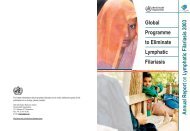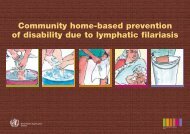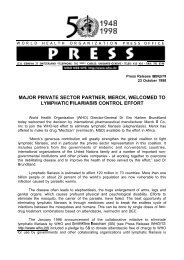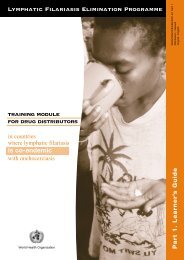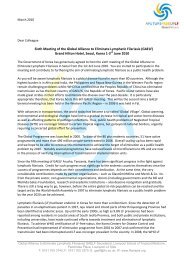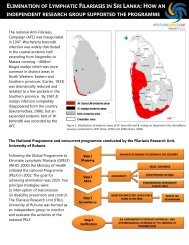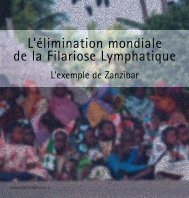English - Global Alliance to Eliminate Lymphatic Filariasis
English - Global Alliance to Eliminate Lymphatic Filariasis
English - Global Alliance to Eliminate Lymphatic Filariasis
Create successful ePaper yourself
Turn your PDF publications into a flip-book with our unique Google optimized e-Paper software.
REPORT OF THE 6 TH GAELF MEETING, JUNE 2010<br />
A 4-8 week course of doxycycline is highly<br />
effective and well-<strong>to</strong>lerated, but the<br />
logistics of delivering long courses of<br />
treatment and contraindications in<br />
children and during pregnancy are<br />
barriers <strong>to</strong> the widespread introduction of<br />
doxycycline for MDA. However, Wanji and<br />
colleagues recently completed a study of<br />
community-directed delivery of a 6-week<br />
course of doxycycline in an area coendemic<br />
for onchocerciasis and loiasis, in<br />
which compliance was 98% and<br />
therapeutic coverage was 74%,<br />
demonstrating that in more restricted<br />
areas this option is both feasible and<br />
achievable [12].<br />
Professor Taylor described the Anti-<br />
Wolbachia Consortium (AWOL), a fiveyear,<br />
$23 million research programme<br />
funded by the Bill & Melinda Gates<br />
Foundation <strong>to</strong> find new anti-Wolbachia<br />
treatments compatible with communitytreatment<br />
programmes for human<br />
filariasis. Activities include refining current<br />
regimens that use doxycycline; developing<br />
assays <strong>to</strong> rapidly screen and test new<br />
drugs that may be even more effective<br />
than doxycycline; studies <strong>to</strong> better<br />
understand the role of Wolbachia in<br />
filarial worms; and identifying the genes<br />
that are essential for the organism’s<br />
survival.<br />
Role of Vec<strong>to</strong>r Control<br />
Professor Moses Bockarie noted that LF is<br />
the only vec<strong>to</strong>r-borne disease that is<br />
transmitted by more than 4 genera of<br />
mosqui<strong>to</strong>es, each with different features<br />
and capacities for transmission. The good<br />
news for LF elimination is that, even in<br />
areas with the most efficient vec<strong>to</strong>rs,<br />
MDA alone can interrupt LF transmission<br />
using 2-drug combinations. However, 19<br />
countries with active LF transmission have<br />
not yet begun MDA. Of these, 13 have<br />
fragile infrastructures or are in postconflict<br />
situations; six others are stable,<br />
but with low LF endemicity. In 17 of these<br />
countries, Anopheles is the principle<br />
vec<strong>to</strong>r for LF.<br />
This is good news for LF elimination. The<br />
efficiency with which Anopheles transmits<br />
LF is low compared <strong>to</strong> other vec<strong>to</strong>r<br />
species, and Anopheles also is the<br />
principle vec<strong>to</strong>r for malaria. Early<br />
experience with DDT house-spraying in<br />
the Solomon Islands, Papua New Guinea,<br />
Togo, and Indonesia showed dramatic<br />
effects on LF transmission [13], and<br />
insecticide-treated bednets (ITNs) are<br />
even more effective than DDT as a malaria<br />
control strategy. A study in Liberia and<br />
one currently underway in Nigeria have<br />
documented the effectiveness of ITNs in<br />
reducing the density of LF infection in<br />
mosqui<strong>to</strong>es under conditions of universal<br />
bednet coverage. Together, these data<br />
suggest that ITNs can have significant<br />
impact on LF transmission.<br />
Thus, Professor Bockarie suggested that in<br />
these 17 countries the LF elimination<br />
strategy should not be “MDA and vec<strong>to</strong>r<br />
control if possible” but, rather, “MDA and<br />
vec<strong>to</strong>r control.” ITNs are being widely<br />
distributed for malaria control, so there is<br />
reason for hope.<br />
Discussion<br />
An animated discussion followed that<br />
<strong>to</strong>uched on the role of vec<strong>to</strong>r control and<br />
the strength of scientific evidence that<br />
ITNs reduce LF transmission, especially<br />
within national programmes. Other<br />
comments focused on the feasibility and<br />
effectiveness of twice-yearly albendazole<br />
in Loa-loa co-endemic areas and the<br />
advantages and disadvantages of various<br />
recommendations put forward by the<br />
presenters, particularly the feasibility of<br />
incorporating antibiotic treatment in<strong>to</strong><br />
operational programmes.<br />
39



